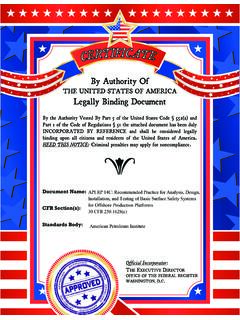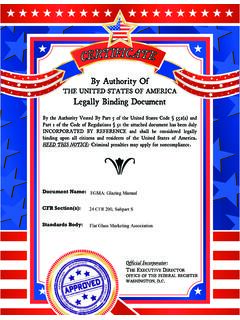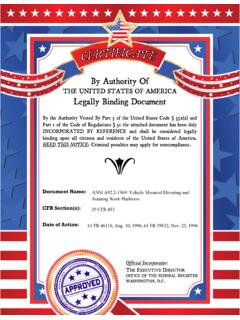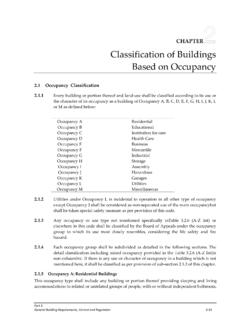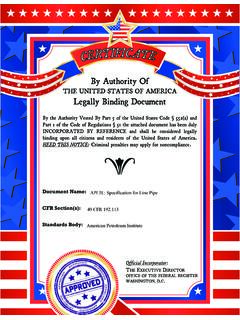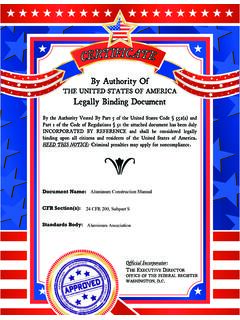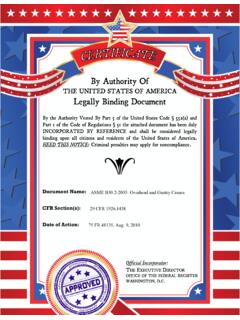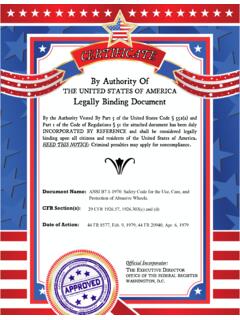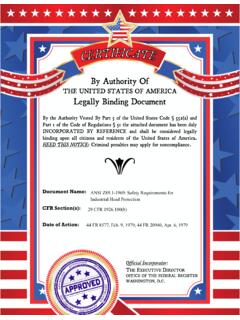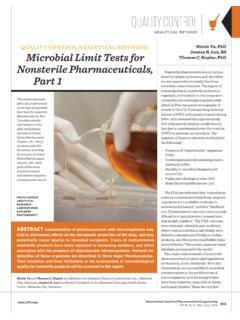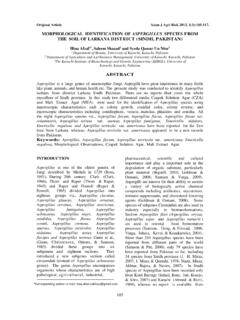Transcription of IS 14648 (2011): Methods of Test for Microbiological ...
1 Disclosure to Promote the Right To InformationWhereas the Parliament of India has set out to provide a practical regime of right to information for citizens to secure access to information under the control of public authorities, in order to promote transparency and accountability in the working of every public authority, and whereas the attached publication of the Bureau of Indian Standards is of particular interest to the public, particularly disadvantaged communities and those engaged in the pursuit of education and knowledge, the attached public safety standard is made available to promote the timely dissemination of this information in an accurate manner to the public. ! $ ' + - Satyanarayan Gangaram Pitroda Invent a New India Using Knowledge 0 1 ' 5 Jawaharlal Nehru Step Out From the Old to the New 1 + , 1 + Mazdoor Kisan Shakti Sangathan The Right to Information, The Right to Live !
2 > 0 B Bhart hari N ti atakam Knowledge is such a treasure which cannot be stolen Invent a New India Using Knowledge IS 14648 (2011): Methods of Test for MicrobiologicalExamination of Cosmetics And Cosmetic Raw Materials [PCD19: Cosmetics] BIS 2011B U R E A U O F I N D I A N S T A N D A R D SMANAK BHAVAN, 9 BAHADUR SHAH ZAFAR MARGNEW DELHI 110002 December2011 Price Group 8IS 14648 : 2011 Indian StandardMICROBIOLOGICAL EXAMINATION OFCOSMETICS AND COSMETIC RAWMATERIALS Methods OF TEST( Second Revision )ICS :70 Cosmetics Sectional Committee, PCD 19 FOREWORDThis Indian Standard (Second Revision) was adopted by the Bureau of Indian Standards, after the draft finalizedby the Cosmetics Sectional Committee had been approved by the Petroleum, Coal and Related Products are used almost universally on a regular basis. The safety in cosmetics and toiletries is of primeimportance, as only safe products should be used by consumers.
3 As a result, awareness has grown both amongthe manufacturers and the health authorities of the hazards involved in using the cosmetics. The Committeeresponsible for formulating this standard agreed that bio-burden of non objectionable micro-organisms beyond aspecific limit and/or presence of pathogenic micro-organisms in cosmetic preparations pose a health hazard tothe consumer; hence it is of great importance to have an appropriate micro-biological standard for the cosmeticproducts depending on nature of product and its end standard was originally published in 1999 and first revised in 2005. This revision for standard has beencarried out to align it with international practices. The key changes and improvements, in line with global andISO norms, in this revision are as follows:a)Inclusion of important pathogens relevant to cosmetics as part of micro-biological safety assurance toconsumers;b) An analytical flow chart for guiding the analyst; andc)Classifying cosmetics on the basis of their micro-biological vulnerability and enabling analytical focuson critical/vulnerable effort of the Committee has been to adopt a risk assessment based approach to ensure consumer safety tests covered in this standard are designed for estimation of number of viable aerobic micro-organismspresent and for detecting presence of designated microbial species in cosmetic products.
4 The general principleinvolved in Microbiological testing of cosmetic products is preparation of sample, plating a known mass ofsample on selected, validated culture media specifically suitable for recovery and growth of bacteria and fungiand incubating them under specified conditions (time and temperature) to permit development of visible coloniesfor step involved in the process is isolation of micro-organisms from cosmetic products based on enrichmentculture wherever necessary, direct dilution and plating. Products that are not water soluble shall be initiallytreated to render them miscible before enrichment or dilution Methods given in this standard are invalid unless it is demonstrated that the test specimens to which they areapplied do not, of themselves inhibit multiplication under the test conditions of micro-organisms that can bepresent.
5 If inhibitory substances are present in the sample, use validated culture media. While carrying outmicrobiological examination, precautions detailed in general recommendations shall be strictly assistance has been derived from international standards on the subject. The list of such referencesis given in Annex reporting the result of a test or analysis made in accordance with this standard, if the final value, observed orcalculated, expressing the result of a test or analysis, shall be rounded off in accordance with IS 2 : 1960 Rulesfor rounding off numerical values (revised) . 1IS 14648 : 2011 Indian StandardMICROBIOLOGICAL EXAMINATION OFCOSMETICS AND COSMETIC RAWMATERIALS Methods OF TEST( Second Revision )1 SCOPEThis standard prescribes Methods for determination ofmicrobial content of cosmetics and cosmetic rawmaterials. This standard lays down widely applicablemethods but does not restrict the use of other validatedmethods.
6 Microbial limits for finished cosmeticproducts are given in Annex A. Guideline for theneutralizers to be used with different preservatives isgiven in Annex TERMS AND DEFINITIONSFor the purpose of this standard the following termsand definitions shall Product Portion of an identified cosmeticproduct received in laboratory for Sample Portion of the product (at least 1 g or1 ml) that is used in the test to prepare initial Diluent This is a suitable liquid used forpreparation of sample dilution that will be subjectedto Neutralizing Diluent Most cosmetics containpreservative which may interfere with estimation ofmicro-organisms. Neutralising diluents inactivatepreservative/anti-microbials and permit micro-organisms in the sample to respond/show upappropriately during Initial Suspension Suspension (or solution) ofthe sample in a defined volume of an appropriateenrichment Sample Dilution Dilution of the GENERAL A schematic flow chart shown in Annex C shall befollowed for all samples that need to be three analyses Total Microbial Count (A), Yeast andMould Count (B) and Enrichment (C) shall be precautions shall be taken by the analystsin order to avoid contaminating the samples andculture media; in addition this will protect them fromacquiring infections:a) Wear laboratory clothing that is light-coloured, clean and in good condition; thisclothing shall not be worn outside the workareas.
7 B) Keep nails perfectly clean and well groomed,and preferably short;c)Wash and disinfect hands, before and aftermicrobiological examinations and imme-diately after visiting the toilets or eating;d) When inoculating, avoid speaking, coughing,etc;e)Do not smoke, drink or eat in the test areas;f)Do not put food for personal consumption inthe laboratory refrigerators;g) Special precautions shall be taken by personshaving infections or illnesses that are likelyto contaminate samples with micro-organisms and may invalidate results;h) Mouth pipetting shall not be allowed in themicrobiology laboratory; andj)All waste material containing live micro-organisms must be autoclaved at 121 C forat least 30 min prior to sterile material, equipment and aseptic techniquesto prepare the sample, initial suspension and is recommended that the samples process fordilutions be plated in to the media at the earliestpreferably within 45 min of Apparatus and Equipment The apparatusrecommended are as specified below or of standarddimensions generally used in Microbiological Te s t Tu b e s Of resistant glass, provided withclosely fitting metal/plastic caps.
8 Diameters 15 mm,length 95 mm or 150 mm are Petri Dishes Of 100 mm diameter and 15mm depth are preferred. The bottom of the dishes shallbe free from bubbles and scratches and shall be , single use plastic petri dishes (90 mm 2IS 14648 : 2011diameter and 15 mm depth) or reusable glass petridishes may be Pipettes, Syringes, Spatulas and Other SuitableSampling Glass Rods, Autoclave The autoclave should be ofsufficient capacity. The autoclave shall maintainuniform temperature within the chamber up to andincluding the sterilizing cycle of 121 C for 20 Colony Counter Counting can be donemanually. If required a suitable magnifying lens or acolony counter may be Incubators Should be capable of maintaininguniform temperatures in the range of 20 C to 35 Water Baths To maintain temperatures at 37 Cand 44 to 48 Media Media may be prepared usingindividual ingredients in laboratory.
9 Alternatively,commercially available dehydrated media may be usedaccording to manufacturer s composition andinstructions. See Annex D for details of compositionsand Microbiological RISK ANALYSESC osmetic products can be categorized for microbialrisk based on the following considerations:a)Water activity (< );b)pH (< 3 and >10);c)Alcohol content (> 20 percent);d) Filling temperature (> 65 C);e) Raw materials which create a hostileenvironment (strong oxidizing or reducingagents, solvents such as ethyl acetate,oxidizing dyes, aluminum chlorohydrate andrelated salts etc); andf)Combined formulations falling into any of the abovecategories can be treated as microbiologically low riskproducts, hence can be exempted from micro-biological ENUMERATION AND DETECTION (TOTALVIABLE COUNT) PrincipleThis method involves enumeration of colonies on anon-selective agar medium (Plate count).
10 The possibleinhibition of microbial growth by the sample shall beneutralized to allow detection of viable Plate CountPlate count consists of the following steps:a)Preparation of poured plates or spread plates,using a specified culture medium, andinoculation of the plates using a definedquantity of the initial suspension or dilutionof the ) Aerobic incubation of the )Counting the number of colony forming units(CFU) and calculation of the number ofaerobic mesophilic bacteria per millilitre orper gram of Diluents and Culture Neutralizing DiluentsFluid casein digest soy lecithin polysorbate 20medium (SCDLP 20 broth)/Eugon LT 100 broth/D/Eneutralizing broth/Modified Latheen broth/InactivatingDiluent. It is generally recommended to use a universalneutralizing agent, for example, D/E neutralizing DiluentPeptone broth/Nutrient Culture Mediaa)For total microbial count Soyabean caseindigest medium (Trypticase Soy agar /TSA).
